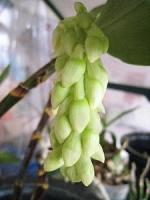Introduction
The citronella plant, also known as Cymbopogon nardus, is a tall grass-like plant that is native to tropical regions such as Asia and Africa. It is known for its strong scent that is believed to repel insects such as mosquitoes. Many people use citronella as a natural insect repellent. But one question that often arises is whether or not the citronella plant flowers. In this article, we will explore the answer to this question in detail.
Characteristics of the Citronella Plant
Before we delve into whether or not the citronella plant flowers, let's first take a look at the characteristics of this plant. The citronella plant is a tall perennial grass that can grow up to 6 feet tall. It has long, narrow leaves that are bluish-green in color, and it produces a strong, lemony scent when its leaves are crushed or rubbed. Citronella plants are often grown for their essential oil, which is extracted from the leaves and is used in a variety of products such as candles, soaps, and lotions.
Does Citronella Plant Flower?
Now, to answer the burning question - does the citronella plant flower? The answer is yes - the citronella plant does flower, but it is not known for its blooms. The plant produces small, inconspicuous flowers that are held on tall stalks above the leaves. The flowers are typically pale yellow in color and appear in late summer or early fall. However, the flowers are not the most notable feature of the citronella plant, and many people may not even notice them unless they are specifically looking for them.
Uses of Citronella Plant
Now that we know that the citronella plant does flower, albeit not with showy blooms, let's take a look at some of the uses of this plant. As mentioned earlier, citronella is often used as a natural insect repellent. This is due to the presence of citronellal and geraniol in the plant's oil, which are believed to repel mosquitoes and other flying insects. Citronella oil is often used in candles, sprays, and lotions to keep bugs at bay. Additionally, the oil is said to have antifungal and antibacterial properties, making it useful for treating skin conditions such as acne and athlete's foot.
Growing Citronella Plant
If you're interested in growing your own citronella plant, there are a few things to keep in mind. The plant thrives in warm, tropical climates and is typically grown as an annual in colder regions. It prefers well-drained soil and should be watered regularly but not overwatered. Citronella plants can be grown from seeds or cuttings, and they should be planted in full sun to promote healthy growth. It's important to note that while the plant is often touted as a mosquito repellent, it should not be relied upon as the sole means of keeping mosquitoes at bay and should be used in tandem with other measures such as mosquito nets and screens.
Conclusion
In conclusion, the citronella plant does indeed flower, but it is not known for its showy blooms. The plant produces small, pale yellow flowers that are held on tall stalks above the leaves. While the flowers may not be the most notable feature of the plant, the citronella plant is still highly valued for its strong, lemony scent and its ability to repel insects. If you're interested in growing your own citronella plant, be sure to keep in mind its preferred growing conditions and the best practices for using the plant as an insect repellent.

 how many times do yo...
how many times do yo... how many planted tre...
how many planted tre... how many pine trees ...
how many pine trees ... how many pecan trees...
how many pecan trees... how many plants comp...
how many plants comp... how many plants can ...
how many plants can ... how many plants and ...
how many plants and ... how many pepper plan...
how many pepper plan...





























